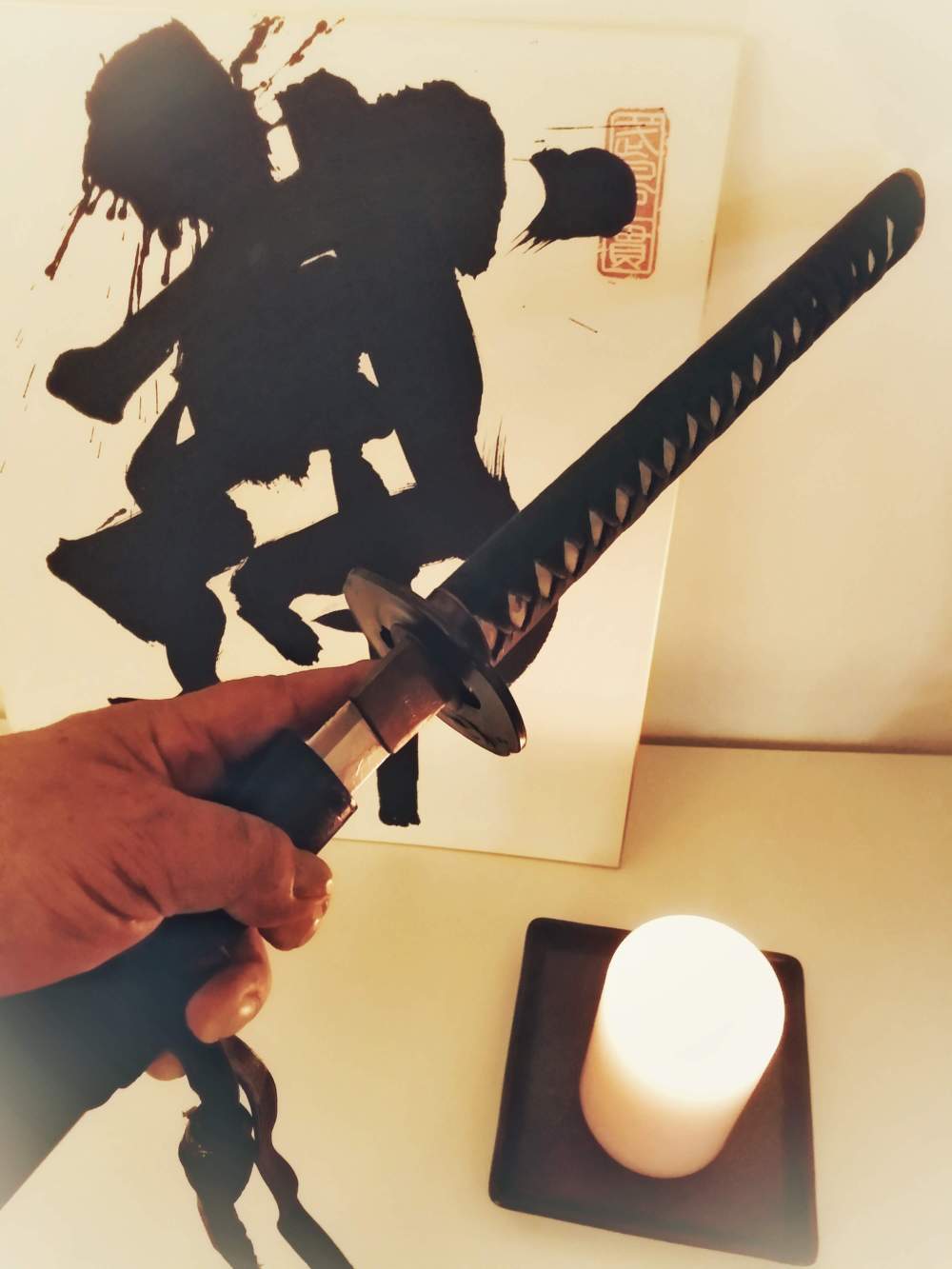From Shiro Kuma by kumafr



From Shiro Kuma by kumafr



From Shiro Kuma by kumafr

Join www.koimartialart.com today…
Read MoreFrom Shiro Kuma by kumafr

In my humble opinion, the Bujinkan Biken Jutsu is not taught enough in our classes. Japanese kanji are cool. Do you know that “biken” meaning “a hidden secret” (1), but another “biken,” means “in my humble opinion.” (2) It is a sign.
As you know, I’m a sword freak. I recently gave a seminar outdoor in Finland on Togakure Happō Biken with my friend Lauri. It was a great seminar. When I came back to my dōjō, I had to teach the Kukishin Biken Jutsu. And I thought it would nice to show both sword systems at the same time.
Next week, I will conduct a seminar in Lugo (Spain) on Biken Jutsu. With the seminar’s organizer, we thought that teaching the two systems would be great. It would give anyone a much better grasp of the rich aspects of sword fighting. Studying the logic of the two sets in the same weekend will provide each participant a good experience. Whether you are a beginner or not, you will get a fantastic understanding of what Biken Jutsu is about.
Teaching the Togakure AND the Kukishin sword techniques in a single seminar will be a “first” for me.
In the Bujinkan, we have nine fighting systems. Only two of them have a densho (3) detailing the waza of the Ryū: the Togakure Ryū Happō Biken, and the Kukishin Ryū Biken Jutsu.
Let me clarifies one thing, here. Each fighting system teaches war. All Ryūha had sword waza because in battle you carry weapons. For some reason, we do not have specific densho except for these two Ryū (or they are not transmitted to us yet).
At first glance, they look entirely different. But this is only an illusion.
On one side, the structure of the Kukishin consists of nine basic forms. They are then multiplied and duplicated into “9 Sayu Gyaku” (4) and “9 henka” (5). This turns the nine basics into twenty-seven forms creating an infinite series of combinations.
On the other side, the structure of the Togakure consists of “only ” seven waza. But, with the correct eye, you discover the same infinite possibility for combinations. To make a long story short, the seven waza are “nine + one.”
When you train one or the other system you cannot see the similarities, only the differences. When you put them side to side, their unity becomes visible. This is what we will do next week in Spain, I hope you can join us. (6)
As my former sword instructor used to say “ancient sword systems were all limited to nine waza. Peacetime created the sword schools of today”. (6) These techniques were then combined together to make surviving possible.
I hope that Jose Camino records the seminar on video. If he does, I will put it on www.koimartialart.com (it will be in Spanish). I have also decided to make a video recording in English next January when I’m in India with Shiva and his Bujinkan India team.
To complete that, I will make a kindle e-book summarizing the mix of these Ryū. (mid-2019). I have to write the ebook because the Japanese language is so creative that “ebook” is also called “densho.” (8)
__________________________
1. Hiken (biken); 秘鍵: hidden mysteries; secret principle.
2. Hiken (biken): 卑見: my humble opinion.
3. Densho; 伝書: book or scroll that has been handed down through generations; a book of secrets.
4. Sayū Gyaku; Sayū; 左右: left and right, but also “control, domination,” or “relative direction.” And Gyaku; 逆: reverse, opposite
5. Henka; 変化; change; variation; alteration; mutation; transition; transformation; transfiguration; metamorphosis .
6. Seminar in Lugo (Spain), September 22nd-23rd: https://www.facebook.com/events/1490695807725786/
7. Nine waza: This French instructor lived in Japan for twenty years. Vice-world champion of Kendō. 7th dan Kendō. 7th dan Iaidō. 6th dan Battōdō. He taught Seitei Iai; Musō Shinden (over 70 kata); and new about 30 ancient styles of sword fighting. On top that, he was a Frenchman, member of the National Japanese Kendō team! He was outstanding and knew a lot.
8. Densho; 電書: electronic book; e-book; ebook.…
Read MoreFrom Shiro Kuma by kumafr

I’m often travelling to Dubai when I’m back from Japan or India. I love to stop here for a few classes when I can. However, my post today is not about Dubai, but about how wrong we can be as a result of expectations and overconfidence.
We know the tale of Odysseus coming back from the Trojan war. And his neverending 10-year trip back home to Ithaca. (1) During his adventures, Odysseus had to pass the dangerous Strait of Messina (Sicily). The legend said that two sea monsters the protected it: Charybdis and Scylla. (2) (3)
I was sad to leave Japan but happy to get out of the deadly heat wave. Training on this trip was more demanding and resembled a sauna experience. Naively, I thought that the Dubai heat would be drier. I was wrong! Like Odysseus, I went from one heat monster into another one.
 Do not expect anything, but be prepared for everything.
Do not expect anything, but be prepared for everything.
Speaking with Anjaan yesterday, he said, “this is like mixing the Dunning-Kruger effect with Murphy’s law!” That is so true!
Reminders
“In the field of psychology, the Dunning–Kruger effect is a cognitive bias in which people of low ability have illusory superiority and mistakenly assess their cognitive ability as greater than it is.” (4) Murphy’s law needs no explanation. (5)
Expectations and Overconfidence are not the proper Mutō Dori.
In the Bujinkan, we learn that failure is always Ok. When I took off from Narita, I knew that it would not be easy. The oracle told Odysseus, before leaving, that his return trip would take years. So, both Odysseus and I knew our fate before leaving (except that I didn’t need an oracle).
At the Bujinkan UAE dōjō yesterday, I was not “expecting” to “have it,” but I tried it anyway. There was no surprise; it was like “Banpen Fugyō” of the Gyokko Ryū. Hatsumi sensei with his Mutō Dori prepares us for it! Be always ready and never surprised!
On a side note and between you and me, Odysseus didn’t make it to Dubai. The Suez canal was not built yet, and I’m not sure that the beautiful Dubai existed yet. (6)

From Shiro Kuma by kumafr






Only 40 participants yesterday night at Sōke’s class. We had so much space to train that the Dōjō felt empty.
It was my last class for this trip, and Sensei taught control with taijutsu, hanbō, knife, sword, and bō.
He insisted again on the importance of control being the theme for this year practice. Controlling is beyond action. At the beginning of the class, he said that “It’s not about taking or not taking, it’s about control.” When we train, we try to copy his movements and do not focus enough on the invisible aspects of what he does. By copying the visible, we cannot grasp the subtle essence of the control. Often he will repeat the same action a few times, but he will adjust it depending on how his partner reacts. Even though we see the different movements, we only do one of his many variations.
When this happens, we tend to forget that control is not about a given technique. About Mutō Dori technique, he said, “I’m not avoiding, I’m just controlling.”
We also trained with two swords. Sensei blocked and controlled the sword of Uke, then swept it away. The sweep action was done by one body movement. This body flow creating a whiplash effect. After letting us try it a few times, he said that “I’m not spinning the sword but going with the flow. It is the body and not the sword that controls the attack.” A whole body movement is the only way to get this. To do that, keep your arms close to the torso and move the body.
Alex Meehan from Ireland was training next to me. He told me that some physiotherapist watched some videos by Sensei. This therapist doesn’t train martial arts at all. But after watching a few clips, he said, “this man [Sōke] is amazing. He has the rare ability to move each part of his body independent of the rest.”
This comment from an outsider is fascinating. We are used to seeing Sōke move the way he does. Because of habit, this prominent aspect of his body movement is so natural to us that we don’t see it anymore. Moving one part of the body, while being fully relaxed in the rest, is what makes the Bujinkan a fantastic martial art.
Unfortunately our insistence in “doing a waza,” doesn’t allow this to happen. If we want to move like Sensei one day, we have to train this.
The “nonchalance” of Sensei’s body, is how he is able to control us. He is not fighting (Tatakai wa Janai) but he is not avoiding either (Yokeru Janai). He said, “I’m teaching all aspects of control, not how to attack.” Control is a complex ability in which our actions can “fool” Uke without the mind even trying to. It is not a decision put into motion, it is a natural body attitude. To reach this, we need to train more, and for a long time.
This is why we fail so often. And this is good. Failing a lot on the mats is the only way to get it right, the day we will need it. In training, there is no right or wrong, only learning. We do our best and fail until we succeed. This is the “fake it, until you have it” principle.
In any case, good or bad, we have to be happy to train.
During the class, Sensei took the knife from Tezuka san and asked him to explain what he had felt. Tezuka san was going to speak when Sensei threw the knife at him. Still caught in his thoughts, he grabbed the knife. He was not watching and was surprised to see it in his hand. Sensei laughed and said, “It is essential to laugh whether it is good or bad.”
Sensei was in an excellent mood, and we laughed a lot. That was a memorable Bujinkan moment. I’m leaving today with this in mind, and I cannot wait to be back in a few months to continue my training with him.
“Good Or Bad, Keep Laughing!” and be happy!
__________________________
I will be back in November 2018 for Sensei’s birthday. Thank you for reading my posts, I hope they help you. Please share your thoughts and experience in the comments. I hope to meet you on the mats one day, in Japan or during a seminar.
Join www.koimartialart.com today and get immediate access to more than 90 Go of Bujinkan techniques.…
Read More